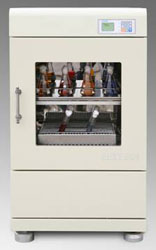Revolutionizing Cultivation: The Double Layer Shaking Incubator
In the dynamic landscape of scientific research, where precision and innovation are paramount, the Double Layer Shaking Incubator emerges as a transformative force. This blog delves into the intricacies of this advanced incubator, exploring its features, applications, and the pivotal role it plays in cultivating a variety of biological and chemical experiments.
Understanding the Double Layer Shaking Incubator: A Fusion of Control and Motion
The Double Layer Shaking Incubator is a cutting-edge instrument designed to provide a controlled environment for the incubation of biological samples. What sets it apart is its dual-layered structure, combining the benefits of a shaking mechanism with a controlled incubation chamber. This fusion of features makes it an indispensable tool in various scientific disciplines.
Key Features of the Double Layer Shaking Incubator:
1. Dual-Layer Design:
- The incubator features two layers – the upper shaking layer for dynamic mixing of samples and the lower incubation layer for maintaining a stable temperature environment. This design maximizes efficiency and flexibility.
2. Shaking Mechanism:
- With a built-in shaking mechanism, this incubator ensures thorough mixing of samples during the incubation process. This is particularly crucial for cell culture studies, biochemical reactions, and other applications requiring agitation.
3. Temperature Control:
- Precise temperature control is maintained within the incubation chamber, providing a stable and optimal environment for the growth and development of biological samples.
4. Variable Speed Shaking:
- Researchers have the flexibility to control the shaking speed, accommodating different experimental requirements. This adaptability is invaluable for various applications, from gentle mixing to vigorous agitation.
Applications Across Scientific Disciplines:
1. Cell Culture Studies:
- The Double Layer Shaking Incubator is instrumental in cell culture studies, ensuring a conducive environment for cell growth and maintaining the necessary conditions for experiments.
2. Microbiology Research:
- Microbiologists benefit from the controlled environment, using the incubator for cultivating microorganisms and conducting experiments that require precise temperature control and shaking.
3. Biochemical and Molecular Biology Experiments:
- In biochemical and molecular biology research, the shaking mechanism aids in homogenizing samples and facilitating reactions, contributing to the accuracy and reproducibility of experiments.
4. Drug Discovery and Development:
- Pharmaceutical researchers rely on the Double Layer Shaking Incubator for drug screening assays, optimizing conditions for cell-based experiments crucial in the early stages of drug development.
Conclusion: Precision, Motion, and Progress
The Double Layer Shaking Incubator stands at the intersection of precision and motion, catalyzing progress in scientific exploration. Its dual-layer design, coupled with the shaking mechanism, opens avenues for diverse experiments, making it an indispensable asset in laboratories pushing the boundaries of biological and chemical research. Embrace a new era of controlled cultivation with the Double Layer Shaking Incubator, where innovation meets reliability in the pursuit of scientific excellence.

Comments
Post a Comment